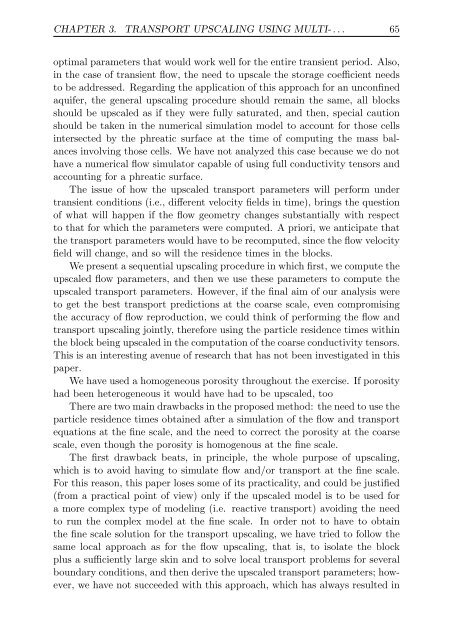Upscaling and Inverse Modeling of Groundwater Flow and Mass ...
Upscaling and Inverse Modeling of Groundwater Flow and Mass ...
Upscaling and Inverse Modeling of Groundwater Flow and Mass ...
Create successful ePaper yourself
Turn your PDF publications into a flip-book with our unique Google optimized e-Paper software.
CHAPTER 3. TRANSPORT UPSCALING USING MULTI- . . . 65<br />
optimal parameters that would work well for the entire transient period. Also,<br />
in the case <strong>of</strong> transient flow, the need to upscale the storage coefficient needs<br />
to be addressed. Regarding the application <strong>of</strong> this approach for an unconfined<br />
aquifer, the general upscaling procedure should remain the same, all blocks<br />
should be upscaled as if they were fully saturated, <strong>and</strong> then, special caution<br />
should be taken in the numerical simulation model to account for those cells<br />
intersected by the phreatic surface at the time <strong>of</strong> computing the mass balances<br />
involving those cells. We have not analyzed this case because we do not<br />
have a numerical flow simulator capable <strong>of</strong> using full conductivity tensors <strong>and</strong><br />
accounting for a phreatic surface.<br />
The issue <strong>of</strong> how the upscaled transport parameters will perform under<br />
transient conditions (i.e., different velocity fields in time), brings the question<br />
<strong>of</strong> what will happen if the flow geometry changes substantially with respect<br />
to that for which the parameters were computed. A priori, we anticipate that<br />
the transport parameters would have to be recomputed, since the flow velocity<br />
field will change, <strong>and</strong> so will the residence times in the blocks.<br />
We present a sequential upscaling procedure in which first, we compute the<br />
upscaled flow parameters, <strong>and</strong> then we use these parameters to compute the<br />
upscaled transport parameters. However, if the final aim <strong>of</strong> our analysis were<br />
to get the best transport predictions at the coarse scale, even compromising<br />
the accuracy <strong>of</strong> flow reproduction, we could think <strong>of</strong> performing the flow <strong>and</strong><br />
transport upscaling jointly, therefore using the particle residence times within<br />
the block being upscaled in the computation <strong>of</strong> the coarse conductivity tensors.<br />
This is an interesting avenue <strong>of</strong> research that has not been investigated in this<br />
paper.<br />
We have used a homogeneous porosity throughout the exercise. If porosity<br />
had been heterogeneous it would have had to be upscaled, too<br />
There are two main drawbacks in the proposed method: the need to use the<br />
particle residence times obtained after a simulation <strong>of</strong> the flow <strong>and</strong> transport<br />
equations at the fine scale, <strong>and</strong> the need to correct the porosity at the coarse<br />
scale, even though the porosity is homogenous at the fine scale.<br />
The first drawback beats, in principle, the whole purpose <strong>of</strong> upscaling,<br />
which is to avoid having to simulate flow <strong>and</strong>/or transport at the fine scale.<br />
For this reason, this paper loses some <strong>of</strong> its practicality, <strong>and</strong> could be justified<br />
(from a practical point <strong>of</strong> view) only if the upscaled model is to be used for<br />
a more complex type <strong>of</strong> modeling (i.e. reactive transport) avoiding the need<br />
to run the complex model at the fine scale. In order not to have to obtain<br />
the fine scale solution for the transport upscaling, we have tried to follow the<br />
same local approach as for the flow upscaling, that is, to isolate the block<br />
plus a sufficiently large skin <strong>and</strong> to solve local transport problems for several<br />
boundary conditions, <strong>and</strong> then derive the upscaled transport parameters; however,<br />
we have not succeeded with this approach, which has always resulted in


